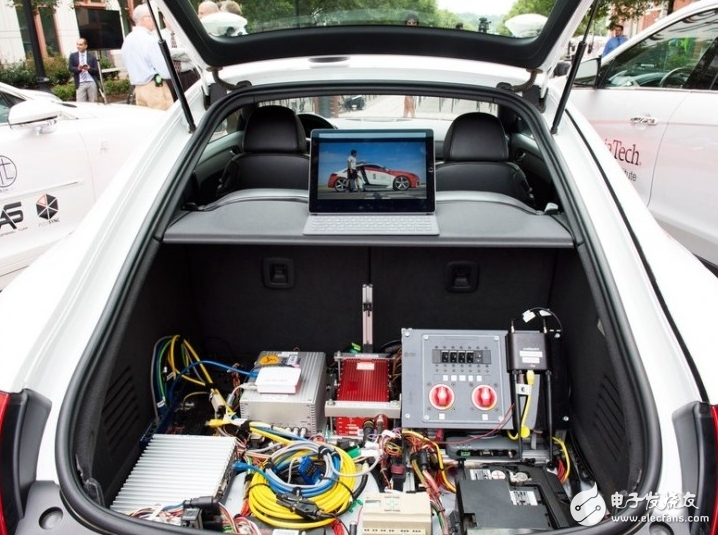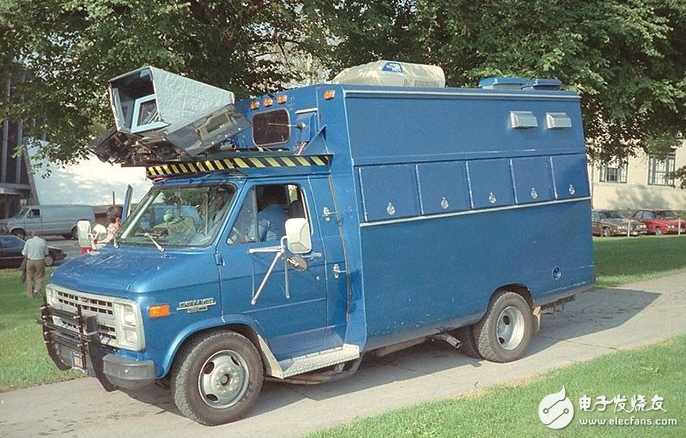Automotive chips can solve many other practical problems. Some of them are available for testing and development. One of the goals of the autonomous driving industry today is to shrink the large equipment on the test car. This will not affect the aesthetics and integrity of the vehicle, and it is very convenient to disassemble when upgrading. In addition, the new chip generates less heat and can be cooled with only a small fan, and it does not take up space. Editor's note: For Pittsburgh natives, it's nothing new to encounter Uber, Argo AI or other companies' self-driving cars on the road. This steel city actually became attached to self-driving cars in the late 1980s. If you were attending Carnegie Mellon University, you would definitely see a very strange car on campus. This bright blue Chevrolet pickup truck is very slow. In terms of car standards, it is just like squirming on campus. Students who have not rushed to class are running fast. However, the NavLab 1 responsible for this project has torn a corner of the autopilot era, although its pace is not fast. Legendary bright blue pickup truck Why do researchers at the Carnegie Mellon Robotics Institute test with a small truck instead of the more fuel-efficient Toyota Prius? The reason is simple, because Toyota started manufacturing hybrid cars ten years later. Secondly, in the era when NavLab developed autonomous vehicles, computers had limited computing power, and they needed enough space to carry various computing and display devices, four engineers and their workbench. The most important thing is that the supercomputers, cameras, huge radar scanners and air conditioners in the car are all power consumers. In order to satisfy their appetite, the minivan is also stuffed with a four-cylinder diesel engine for power generation. Thirty years later, companies have inherited Carnegie Mellon's robes, which are turning autonomous cars into reality. However, in addition to supervision, responsibility, safety, business model and mass production issues, companies have not forgotten the energy consumption of self-driving cars. They are all “electric tigersâ€. Today's self-driving cars definitely don't have to install a dedicated engine, but driving the sensors on the car and the super-powerful supercomputer still consume a lot of power. In the future, this problem will gradually ferment and become a stumbling block on the road ahead of self-driving cars. The car is full of various equipment Right now, the production cars that can be bought on the market, although equipped with only cameras and radars, can still generate 6GB of massive data every half minute, while the self-driving cars equipped with lidars will generate data. Geometry growth. It is understood that computers need to integrate, classify and convert all data into pictures that can be understood by computers. This process consumes a lot of computing power, which means that a sufficient power supply is needed. Today's test cars typically consume up to 2,500 watts (2.5 kWh), and so much power is enough to illuminate 40 incandescent lights. “Putting such a system into a traditional diesel locomotive simply won’t work because the vehicle’s fuel consumption will rise sharply,†explains Wilko Stark, vice president of strategy at Mercedes-Benz. If you switch to an electric car, it means that the cruising range is reduced because the computer and the motor are rushing to use electricity. At first, companies may choose to ignore the decline in the range of electric vehicles or the increase in fuel consumption of diesel locomotives. “This is really not a problem in early applications, because our main goal is to get the autonomous car running,†explains Chris Urmson, former head of Google's unmanned vehicle. After leaving Google, Urmson founded Aurora, which is now a partner of Volkswagen, Hyundai and Chinese startups. In addition, Urmson also pointed out that the first self-driving cars must be electric shuttles deployed in the city, they are slower and conditionally charged frequently. In the new era of new generations, they certainly have not experienced the painful experience of the fathers when they drove to turn off the air conditioner. If we enter the era of electric vehicles, we should also turn off the autopilot function to ensure that we can successfully achieve the goal. What about the land? The good news is that people who build chips for the "brains" of autonomous cars have been paying attention to this problem. At last month's CES, NVIDIA released the Xavier platform for self-driving cars with an 8-core CPU and 512 GPU cores. In addition, the platform is equipped with a deep learning accelerator, a computational visual accelerator and an 8K video processor. Nvidia said that this is the most complex SoC it has ever developed. "We will be able to bring the computing power of the data center to the car," said Danny Shapiro, head of NVIDIA's automotive business. However, behind such a powerful ability is the reduction in power consumption. “Xavier can perform 30 trillion (TOPS) operations per second, but consumes only 30 watts.†For fully automated vehicles, this performance data is not bright enough, but NVIDIA is actually ready: Pegasus platform. This platform uses two Xavier chips and adds two more GPUs with a computing power of 320 TOPS and a power consumption of 500 watts, which is perfectly acceptable. NVIDIA's opponents are also chasing the same goal, including Intel, Tesla, Qualcomm and other companies are developing autonomous driving chips, and low power consumption is an important indicator. Automotive chips can solve many other practical problems. If you've seen the trunk of an existing self-driving test car, you'll find a lot of computing equipment piled up here. Some of them are available for testing and development because the designer wants to get every piece of data that can be used. However, the officially available version of the future will require much less hardware.
Best Budget I7 Laptop is everyone eager to. Laptop Intel Core i7 is the No. 1 processor clients choose when they are searching for a performance Gaming Laptop,cause it`s of excellent powering, bigger Solid State Drive, usually 512GB based, full HD 16:9 aspect ratio slimmer display bezels, bigger battery-12000mAh-no need to worry lack of power, fingerprint reader, backlight keyboard, etc. What is intel Core I7 Laptop Price? Usually 300-400usd. You can get Intel i7 11th Generation Laptop, Intel i7 10th Generation Laptop, Intel I5 11th Generation Laptop, Laptop I3 11th Generation,etc. 15.6 or 14 inch all available for i7 processor.
Cooperating with us, you just need to share all your requirements details, like size, cpu, ram, rom, battery, fingerprint, backlight, enter button numbers, SSD+HDD or only SSD ok, if need oem service, if need logo position, special apps preinstall if need, etc. Can provide matched and value feedback in 1-2 working days.
The reason why clients choose us is that just half of DOA than others, longer warranty time, smaller MOQ, fast delivery, competitive cost, good after-sale service, etc.
Laptop Intel Core I7,Intel Core I7 Laptop Price,Best Budget I7 Laptop,Intel I7 11th Generation Laptop,Intel I7 10th Generation Laptop Henan Shuyi Electronics Co., Ltd. , https://www.shuyilaptop.com

